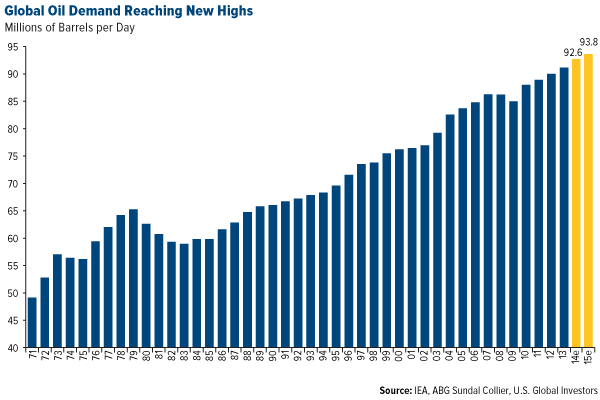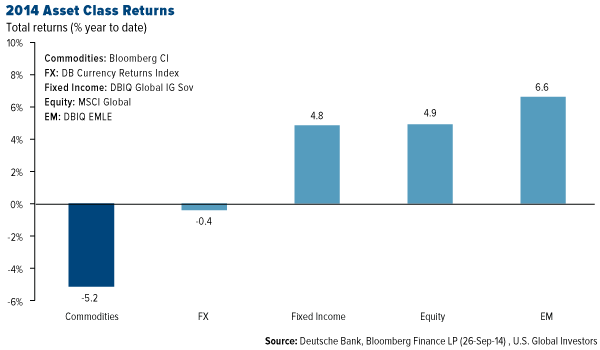Warning: Market Correction This Week…Did You See The Opportunity?
Last week we saw a continued selloff in energy stocks and a slump in commodity prices, specifically oil. In light of this, I’ve highlighted some key points I made during our latest webcast that might offer investors some clarity and insight into our management strategy when such market nervousness occurs.
One of the main drivers of commodity demand, as I often point out, is PMI, or purchasing managers’ index:
PMI: Commodities’ Crystal Ball
You look at the stock market as a precursor to economic activity six months out. If you’re looking at commodities, you must be looking at PMIs.

What our research has shown is that there is a 60- to 80-percent probability of commodities and commodity stocks rising when the global PMI’s one-month reading is above the three-month trend. When its one-month is below the three-months, there is a high probability of these sectors and stocks falling over the next six months.

The global PMI reading is a composite of each country’s unique PMI. So we look at individual countries and try to gauge what their monetary and fiscal policies are going to be. These government policies have a high correlation to commodity demand, which is significant to resource investments.
Brian Hicks
 Brian Hicks, portfolio manager of our Global Resources Fund (PSPFX), stepped in to share his thoughts on the resources sector, devoting special attention to the recent performance of crude oil.
Brian Hicks, portfolio manager of our Global Resources Fund (PSPFX), stepped in to share his thoughts on the resources sector, devoting special attention to the recent performance of crude oil.
Despite the recent selloff, I believe it’s actually an excellent time to be looking at resource stocks and energy stocks in particular.
The Polarity of the Dollar and Crude Oil
The following chart mathematically depicts the oversold nature of crude oil:

The dollar is significantly overbought relative to crude oil. The dollar is up almost two standard deviations, crude oil down almost one standard deviation. History has shown, whether it’s in 2011 or 2012, that this has been a good time to buy crude oil.
Natural Resources Stocks Priced to Move
Another factor that gets me excited about these energy stocks and natural resource stocks is the metrics that we’re seeing from a fundamental standpoint. Looking at the top 50 holdings for our Global Resources Fund, what jumps out immediately is just how cheap these stocks are relative to their growth rate, trading at 20 times in the last quarter earnings. Sales were growing at over 20 percent.

These companies are very profitable, generating return on equity of 25 percent, paying a dividend yield on average—about 2.7 percent—and growing that dividend at about a 30-percent click. And as you can see, these stocks have outperformed the S&P 500 Index so far year-to-date (YTD), even with this pullback.
A Thirst for Oil
Looking at global oil demand, you can see it’s been unrelenting through recessions, through bull markets, bear markets, and it looks like it’s going to continue to go up at a fairly steady level based on latest data from the U.S. Energy Information Administration (EIA).

Below is a very important point to consider. Where oil prices are now, we’re getting to the area where production could be cut off because prices are not high enough to incentivize new development, new production and new drilling.

If you look at crude oil price somewhere in the area of $80 to $90, we have about 650,000 barrels per day of production that need to be supported at that particular level. So we really can’t go too much lower in terms of pricing. Otherwise, we would see a significant drop in the supply of oil.
Just to give you a sense of the scale here, we’re expected to grow demand by one million barrels per day, and we have 650,000 barrels that need an oil price north of $80.
Pricing Black Gold to Stay in the Black
Another significant factor is the price that’s necessary for countries that produce crude oil or export crude oil out of the Organization of the Petroleum Exporting Countries (OPEC) or non-OPEC.

On average, you need to see $95-per-barrel prices in order for these countries to balance their budgets—their fiscal budgets. What really sticks out is Russia and Saudi Arabia. They’re the two largest exporters of crude oil and, as you can see above, Russia requires an oil price north of $100, Saudi Arabia right at about $95 per barrel on a Brent basis, and we’re below that number now.
The next OPEC meeting is in November. I would be surprised if we did not see another production cut if oil prices remain at these levels. I think that OPEC and the Saudis need to come in and support prices even more so than they already have following the cut in August.
U.S. Gushing Oil
One area that’s been very topical and interesting as of late is the growth in U.S. crude oil production. It’s at a new 25-year high.

We’ve gone from basically 4.5 million barrels in 2008 to 8.5 million barrels. Energy stocks are no longer just the commodity play. They’re also a volume growth play.
You can see this paradigm shift in that many of these shale producers have gone out and invested a lot of capital over the years and now, over the next two years or so, we’re going to start to see a free cash flow payback on that initial investment and infrastructure in fracking and developing their resource.

Because they’re going to start seeing free cash flow, I think there’s the potential we could get a rerating in multiples to that cash flow. Instead of trading four to six times, maybe we trade higher, somewhere between seven or eight times due to that positive free cash flow metric.
Commodities: A Value Play
Commodities have way underperformed other asset classes, bonds, U.S. equity, and we feel like this is where the value is at. This is the area where you can put capital to work for the long term and outperform, whereas some of the other areas such as in bonds or U.S. stocks may not perform as well.

There are pockets of strength within the commodity sector where I think we will see companies profit and do well. On the whole, given this pullback, I’m very optimistic about resources going forward.
________________________________________________________________________
 No Faith in the G20 Central Bankers
No Faith in the G20 Central Bankers
Last weekend the finance ministers and central bank governors of the world’s top 20 economies will meet in Washington to discuss, among other issues, solutions to Europe’s weak economic performance. The region, whose sluggishness has negatively affected the global market, is at risk of dipping into its third recession since 2008.
I have no confidence that this body can persuade Europe to act sooner rather than later to dig itself out of further economic hardship. As I’ve observed in my global travels, the G20 central bankers are not interested in promoting and facilitating trade among nations. Instead, they’re interested foremost in levying more taxes and imposing more regulations that actually impede international trade.
It’s Economics 101: Capital cannot be spurred or created with high taxes and strangulating regulations.
European Central Bank President Mario Draghi assures the media that the eurozone will recover soon, but as we wait, the region continues to underperform and drag the rest of the markets down with it. European growth in the second quarter was flat, and this quarter doesn’t look as if it will fare much better. France’s manufacturing sector has steadily contracted. Over the last 12 months, it’s seen only two PMI scores above 50, which would indicate expansion. Even usually-reliable Germany, the eurozone’s largest economy, is in the midst of a downturn.
The U.S. has been gradually recovering from its worst economic period since the Great Depression, and to continue this progress, we need strong trading partners. Investors have become impatient waiting for Europe to get its fiscal act together and stop trying to rationalize even more taxes and regulations.
If it weren’t for the U.S. and Canada propping up the rest of the world, Europe would likely be in a more depressed state than it already is.
Again, you can still catch the replay of last week’s webcast, which includes more on macroeconomics and a timely discussion of gold and gold stocks with portfolio manager Ralph Aldis.
********
Please consider carefully a fund’s investment objectives, risks, charges and expenses. For this and other important information, obtain a fund prospectus by visiting www.usfunds.com or by calling 1-800-US-FUNDS (1-800-873-8637). Read it carefully before investing. Distributed by U.S. Global Brokerage, Inc.
Foreign and emerging market investing involves special risks such as currency fluctuation and less public disclosure, as well as economic and political risk. Because the Global Resources Fund concentrates its investments in specific industries, the fund may be subject to greater risks and fluctuations than a portfolio representing a broader range of industries.
The J.P. Morgan Global Purchasing Manager’s Index is an indicator of the economic health of the global manufacturing sector. The PMI index is based on five major indicators: new orders, inventory levels, production, supplier deliveries and the employment environment.
The S&P 500 Stock Index is a widely recognized capitalization-weighted index of 500 common stock prices in U.S. companies. The S&P 500 Materials Index is a capitalization-weighted index that tracks the companies in the material sector as a subset of the S&P 500. The S&P 500 Energy Index is a capitalization-weighted index that tracks the companies in the energy sector as a subset of the S&P 500. The S&P 1500 Energy Index is an unmanaged market capitalization index that tracks the companies in the energy sector as a subset of the S&P 1500.
There is no guarantee that the issuers of any securities will declare dividends in the future or that, if declared, will remain at current levels or increase over time. Note that stocks and Treasury bonds differ in investment objectives, costs and expenses, liquidity, safety, guarantees or insurance, fluctuation of principal or return, and tax features.
Standard deviation is a measure of the dispersion of a set of data from its mean. The more spread apart the data, the higher the deviation. Standard deviation is also known as historical volatility.
All opinions expressed and data provided are subject to change without notice. Some of these opinions may not be appropriate to every investor. Past performance does not guarantee future results. This news release may include certain “forward-looking statements” including statements relating to revenues, expenses, and expectations regarding market conditions. These statements involve certain risks and uncertainties. There can be no assurance that such statements will prove accurate and actual results and future events could differ materially from those anticipated in such statements.






 Frank Holmes is the CEO and Chief Investment Officer of
Frank Holmes is the CEO and Chief Investment Officer of 










